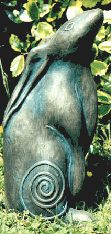 The following is excerpted from Swain Wodening's essay on the Goddess Eostre. This essay was first published at Wednesbury Shire of White Marsh Theod.
The following is excerpted from Swain Wodening's essay on the Goddess Eostre. This essay was first published at Wednesbury Shire of White Marsh Theod.______________________________
Eostre is a very obscure Goddess, and uniquely Anglo-Saxon Pagan. She is not mentioned at all in the Norse corpus and only fleetingly in the Old English by Bede in De Temporum Rationale. Her material is so scant that some scholars have speculated she was not a Goddess at all, but that Eostre was merely a name for the holiday. Her name is connected for words for "east" and "shining." It is therefore related to the Greek godname Eos, Goddess of the dawn in their pantheon. Finding place names indicating her worship are difficult due to this relation to the word east. Her name survived in the German name of the Christian holy tide as Ostara, therefore if she was a Goddess, she was worshipped there as well.In order to understand anything about the Goddess Eostre (or the Goddess or Goddesses worshiped at that time) we must draw on the traditions associated with the holy tide. Grimm in his Teutonic Mythology maintained that "Ostara, Eástre, was goddess of the growing light of spring." The date of the holy tide would make this a reasonable conclusion. Holy water in the form of the dew or water collected from brooks was gathered at this time. Washing with it was said to restore youth. Beautiful maidens in sheer white were said to seen frolicking in the country side. Also according to Grimm, the white maiden of Osterrode, was said to appear with a large batch of keys at her belt, and stride to the brook to collect water on Easter morning. Cross buns were of course baked and eaten. While this could be a Christian addition, that cakes were often use in Heathen rites is apparent in any survey of the lore. And the cross may be symbolic of the rune Gebo or the buns may represent the sun wheel. Easter eggs seem to go fairly far back in both English and continental celebrations, and of course symbolize the beginning of new life. The hare also known for its fertility appears fairly early in Easter celebrations. Bonfires and vigils also seemed to play a role in many Easter rites.Based on this, Eostre would appear to be a Goddess of purity (the holy water), youth and beauty (the young maidens), as well as one of new life beginnings. . . .To read Swain Wodening's piece on Eostre in its entirety, click here.
Image: Artist unknown.



































